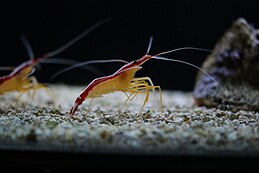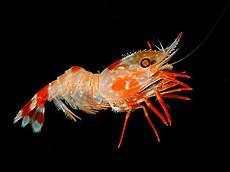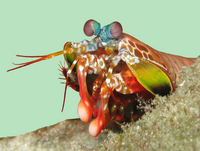Shrimp

A shrimp (pl.: shrimp (US) or shrimps (UK)) is a crustacean (a form of shellfish) with an elongated body and a primarily swimming mode of locomotion – typically belonging to the Caridea or Dendrobranchiata of the order Decapoda, although some crustaceans outside of this order are also referred to as "shrimp".
More narrow definitions may be restricted to Caridea, to smaller species of either group or to only the marine species. Under a broader definition, shrimp may be synonymous with
Shrimp are widespread and abundant. There are thousands of species adapted to a wide range of habitats. They can be found feeding near the seafloor on most coasts and estuaries, as well as in rivers and lakes. To escape predators, some species flip off the seafloor and dive into the sediment.[3] They usually live from one to seven years.[4] Shrimp are often solitary, though they can form large schools during the spawning season.[3][5]
They play important roles in the
Many shrimp species are small as the term shrimp suggests, about 2 cm (0.79 in) long, but some shrimp exceed 25 cm (9.8 in). Larger shrimp are more likely to be targeted commercially and are often referred to as prawns, particularly in the Commonwealth of Nations and former British colonies.
Classification
From Raymond Bauer in Remarkable Shrimps:[6]
- Shrimp is characteristically used to refer to those crustaceans with long antennae, slender legs, and a laterally compressed, muscular abdomen that is highly adapted for both forward swimming and a backward (retrograde) escape response.
- Prawn is often used as a synonym of shrimp for
penaeoidean and caridean shrimp, especially those of large size.
From the English Oxford Dictionaries:
Shrimp are swimming
| Differences between shrimp, lobsters and crabs | ||
|---|---|---|
| Shrimp are slender with long muscular abdomens. They look somewhat like small lobsters, but not like crabs. The abdomens of crabs are small and short, whereas the abdomens of lobsters and shrimp are large and long. The lower abdomens of shrimp support pleopods which are well-adapted for swimming. The carapaces of crabs are wide and flat, whereas the carapaces of lobsters and shrimp are more cylindrical. The antennae of crabs are short, whereas the antennae of lobsters and shrimp are usually long, reaching more than twice the body length in some shrimp species.[3][10][11][12] | Clawed lobsters (pictured left) and spiny lobsters (pictured right) are an intermediate evolutionary development between shrimp and crabs. They look somewhat like large versions of shrimp. Clawed lobsters have large claws while spiny lobsters do not, having instead spiny antennae and carapace. Some of the biggest decapods are lobsters. Like crabs, lobsters have robust legs and are highly adapted for walking on the seafloor, though they do not walk sideways. Some species have rudimentary pleopods, which give them some ability to swim, and like shrimp they can lobster with their tail to escape predators, but their primary mode of locomotion is walking, not swimming.[3][10][11][13]
|
|
Description
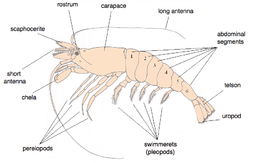

The following description refers mainly to the external anatomy of the common European shrimp,
Eight pairs of appendages issue from the cephalothorax. The first three pairs, the
The muscular abdomen has six segments and has a thinner shell than the carapace. Each segment has a separate overlapping shell, which can be transparent. The first five segments each have a pair of appendages on the underside, which are shaped like paddles and are used for swimming forward. The appendages are called
Habitat
Shrimp are widespread, and can be found near the seafloor of most coasts and estuaries, as well as in rivers and lakes. There are numerous species, and usually there is a species adapted to any particular habitat.
Behaviour
There are many variations in the ways different types of shrimp look and behave. Even within the core group of
Most shrimp are
Mating
Females of the freshwater shrimp Caridina ensifera are capable of storing sperm from multiple partners, and thus can produce progeny with different paternities.[27] Reproductive success of sires was found to correlate inversely with their genetic relatedness to the mother.[27] This finding suggests that sperm competition and/or pre- and post-copulatory female choice occurs. Female choice may increase the fitness of progeny by reducing inbreeding depression that ordinarily results from the expression of homozygous deleterious recessive mutations.[28]
Species
Decapods
There is little agreement among taxonomists concerning the
Traditionally,
However, classifications are now based on clades, and the paraphyletic suborder Natantia has been discontinued. "On this basis, taxonomic classifications now divide the order Decapoda into the two suborders: Dendrobranchiata for the largest shrimp clade, and Pleocyemata for all other decapods. The Pleocyemata are in turn divided into half a dozen infra-orders"[34]
- The taxonomists De Grave and Fransen, 2011, recognise four major groups of shrimp: the suborder Dendrobranchiata and the infraorders Procarididea, Stenopodidea and Caridea".[35] This group is identical to the traditional Natantia group, and contains decapods only.
- All shrimp of commercial interest belong to the Natantia. The FAO determine the categories and terminology used in the reporting of global fisheries. They define a shrimp as a "decapod crustacean of the suborder Natantia".[36]
- According to the Codex Alimentarius Commission of the WHO: "The term shrimp (which includes the frequently used term prawn) refers to the species covered by the most recent edition of the FAO listing of shrimp, FAO Species Catalogue, Volume 1, Shrimps and prawns of the world, an annotated catalogue of species of interest to fisheries FAO Fisheries Synopsis No. 125."[37] In turn, the Species Catalogue says the highest category it deals with is "the suborder Natantia of the order Crustacea Decapoda to which all shrimps and prawns belong".[38]
| Major shrimp groups of the Natantia | |||||
|---|---|---|---|---|---|
| Order | Suborder | Infraorder | Image | Extant species [32]
|
Description |
| Decapoda | Dendrobranchiata | 
|
533 | The species in this suborder tend to be larger than the caridean shrimp species below, and many are commercially important. They are sometimes referred to as prawns. Dendrobranchiata, such as the | |
| Pleocyemata | Caridea | 
|
3438 | The numerous species in this infraorder are known as caridean shrimp, though only a few are commercially important. They are usually small, nocturnal, difficult to find (they burrow in the sediment), and of interest mainly to marine biologists. Caridean shrimp, such as the pink shrimp pictured, typically have two pairs of claws. Female carideans attach eggs to their pleopods and brood them there. The second abdominal segment overlaps both the first and the third segment, and the abdomen shows a pronounced caridean bend.[3][9][39][40] | |
| Procarididea | 
|
6 | A minor sister group to the Caridea (immediately above) | ||
| Stenopodidea | 
|
71 | Known as banded coral shrimp (pictured) is popular in aquariums. The Stenopodidea are a much smaller group than the Dendrobranchia and Caridea, and have no commercial importance.[41]
| ||
Other decapod crustaceans also called shrimp, are the ghost or mud shrimp belonging to the infra-order
Non-decapods
A shrimp seems to be almost any crustacean that isn't a lobster, barnacle, or crab
– Greg Jensen [3]
A wide variety of non-decapod crustaceans are also commonly referred to as shrimp. This includes the
| Other species groups commonly known as shrimp | |||||
|---|---|---|---|---|---|
| Class | Image | Group | Extant species
|
Description | |
| Branchiopoda | Branchiopoda comes from the Greek branchia meaning gills, and pous meaning feet.[45] They have gills on their feet or mouthparts.[46] | ||||

|
brine shrimp | 8 | Brine shrimp belong to the genus fish feed in aquaculture.[47] Brine shrimp are sold as novelty gifts under the marketing name Sea-Monkeys .
| ||

|
clam shrimp | 150 | Clam shrimp belong to the group bivalved carapace which can open and close.
| ||

|
fairy shrimp
|
300 | Fairy shrimp belong to the class fairy shrimp are herbivores, and eat only the algae in the plankton. Their eggs can survive drought and temperature extremes for years, reviving and hatching after the rain returns.[48]
| ||

|
tadpole shrimp
|
20 | longtail tadpole shrimp (pictured) has three eyes and up to 120 legs with gills on them.[50] It lives for 20–90 days. Different populations can be bisexual, unisexual or hermaphroditic .
| ||
| Malacostraca | Malacostraca comes from the Greek malakós meaning soft and óstrakon meaning shell.[51] The name is misleading, since normally the shell is hard, and is soft only briefly after moulting.[52] | ||||

|
Lophogastrida | 56 | These marine opossum shrimp, females lophogastrida carry a brood pouch.[53]
| ||
| mantis shrimp | 400 | Mantis shrimp, so called because they resemble a Stomatopoda. They grow up to 38 cm (15 in) long, and can be vividly coloured. Some have powerful spiked claws which they punch into their prey, stunning, spearing and dismembering them. They have been called "thumb splitters" because of the severe gashes they can inflict if handled carelessly.[54]
| |||

|
opossum shrimp
|
1,000 | Opossum shrimp belong to the order | ||

|
skeleton shrimp
|
Skeleton shrimp, sometimes known as ghost shrimp, are amphipods. Their threadlike slender bodies allow them to virtually disappear among fine filaments in seaweed. Males are usually much larger than females.[56][57] For a good account of a specific species, see Caprella mutica. | |||
Ostracoda
|
bivalves or clams .
| ||||

|
seed shrimp
|
13,000 | Ostracoda. This is a class of numerous small crustacean species which look like seeds, typically about one millimetre (0.04 in) in size. Their carapace looks like a clam shell, with two parts held together by a hinge to allow the shell to open and close. Some marine seed shrimp drift as pelagic plankton, but most live on the sea floor and burrow in the upper sediment layer. There are also freshwater and terrestrial species. The class includes carnivores, herbivores, filter feeders and scavengers.[58]
| ||
Some mantis shrimp are a foot long, and have bulging eyes, a flattened tail and formidable claws equipped with clubs or sharp spikes, which it can use to knock out its opponents.[12][54]
Human uses
History
In 1991, archeologists suggested that ancient raised paved areas near the coast in Chiapas, Mexico, were platforms used for drying shrimp in the sun, and that adjacent clay hearths were used to dry the shrimp when there was no sun.[60][61] The evidence was circumstantial, because the chitinous shells of shrimp are so thin they degrade rapidly, leaving no fossil remains. In 1985 Quitmyer and others found direct evidence dating back to 600 AD for shrimping off the southeastern coast of North America, by successfully identifying shrimp from the archaeological remains of their mandibles (jaws).[62][63][64] Clay vessels with shrimp decorations have been found in the ruins of Pompeii.[64] In the 3rd century AD, the Greek author Athenaeus wrote in his literary work, Deipnosophistae; "... of all fish the daintiest is a young shrimp in fig leaves."[65]
In North America,
""For shrimp to develop into one of the world's most popular foods, it took the simultaneous development of the
In the 1920s, diesel engines were adapted for use in shrimp boats.
As shrimp fishing methods industrialised, parallel changes were happening in the way shrimp were processed. "In the 19th century, sun dried shrimp were largely replaced by canneries. In the 20th century, the canneries were replaced with freezers."[64]
In the 1970s, significant shrimp farming was initiated, particularly in China. The farming accelerated during the 1980s as the quantity of shrimp demand exceeded the quantity supplied, and as excessive bycatch and threats to endangered sea turtles became associated with trawling for wild shrimp.[64] In 2007, the production of farmed shrimp exceeded the capture of wild shrimp.[59]
Commercial species
Although there are thousands of species of shrimp worldwide, only about 20 of these species are commercially significant. The following table contains the principal commercial shrimp, the seven most harvested species. All of them are decapods; most of them belong to the
| Principal commercial shrimp species | ||||||||||||
|---|---|---|---|---|---|---|---|---|---|---|---|---|
| Group | Common name | Scientific name | Description | Max length (mm) | Depth (m) | Habitat | FAO
|
WoRMS
|
2010 production (thousand tonnes) | |||
| wild | farmed | total | ||||||||||
| Dendrobranchiata | Whiteleg shrimp | Litopenaeus vannamei (Boone, 1931)
|
The most extensively farmed species of shrimp. | 230 | 0–72 | marine, estuarine | [68][69] | [70] | 1 | 2721 | 2722 | |
| Giant tiger prawn | Penaeus monodon Fabricius, 1798 | 336 | 0–110 | marine, estuarine | [71][72] | [73] | 210 | 782 | 992 | |||
| Akiami paste shrimp | Acetes japonicus Kishinouye, 1905 | Most intensively fished species. They are small with black eyes and red spots on the fermented.[74]
|
30 | shallow | marine | [75][76] | [77] | 574 | 574 | |||
| Southern rough shrimp | Trachysalambria curvirostris (Stimpson, 1860) | Easier to catch at night, and fished only in waters less than 60 m (200 ft) deep.[78] Most of the harvest is landed in China.[79] | 98 | 13–150 | marine | [80][81] | [82] | 294 | 294 | |||
| Fleshy prawn | Fenneropenaeus chinensis (Osbeck, 1765)
|
Trawled in Asia where it is sold frozen. Exported to Western Europe. Cultured by Japan and South Korea in ponds.[83] | 183 | 90–180 | marine | [83][84] | [85] | 108 | 45 | 153 | ||
| Banana prawn | Fenneropenaeus merguiensis (De Man, 1888) | Typically trawled in the wild and frozen, with most catches made by Indonesia. Commercially important in Australia, Pakistan and the Persian Gulf. Cultured in Indonesia and Thailand. In India it tends to be confused with Fenneropenaeus indicus, so its economic status is unclear.[86]
|
240 | 10–45 | marine, estuarine | [86][87] | [88] | 93 | 20 | 113 | ||
| Caridea | Northern prawn | Pandalus borealis (Krøyer, 1838) | Widely fished since the early 1900s in Norway, and later in other countries following Johan Hjort's practical discoveries of how to locate them. They have a short life which contributes to a variable stock on a yearly basis. They are not considered overfished. | 165 | 20–1380 | marine | [89][90] | [91] | 361 | 361 | ||
| All other species | 1490
|
220
|
1710
| |||||||||
| Combined total | 3129 | 3788 | 6917 | |||||||||
Fishing
Commercial techniques for catching wild shrimp include otter trawls, seines and shrimp baiting. A system of nets is used when trawling. Baited traps are common in parts of the Pacific Northwest.
Shrimp trawling can result in very high
The most extensively fished species are the
Farming
A shrimp farm is an
As can be seen from the global production chart on the left, significant aquaculture production started slowly in the 1970s and then rapidly expanded during the 1980s. After a lull in growth during the 1990s, due to pathogens, production took off again and by 2007 exceeded the capture from wild fisheries. By 2010, the aquaculture harvest was 3.9 million tonnes, compared to 3.1 million tonnes for the capture of wild shrimp.[59]
In the earlier years of marine shrimp farming the preferred species was the large
The major producer of farmed shrimp is China. Other significant producers are Thailand, Indonesia, India, Vietnam, Brazil, Ecuador and Bangladesh. Most farmed shrimp is exported to the United States, the European Union and Japan,[98] also other Asian markets, including South Korea, Hong Kong, Taiwan and Singapore.[95]
Investigations by
As food
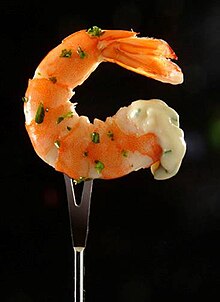
Shrimp are
As with other seafood, shrimp is high in
Ebiko - shrimp roe, sometimes translated as "shrimp flakes" - is used as one of the ingredients in the preparation of sushi.[106]
Shrimp and other
Aquaria
Several types of shrimp are kept in home
| Freshwater aquaria variant shrimp come in many colours |
|---|
cherry shrimp .Caridina cantonensis crystal red bee shrimp has broad red and white stripes. |
Shrimp versus prawn
The terms shrimp and prawn are
According to the crustacean taxonomist Tin-Yam Chan, "The terms shrimp and prawn have no definite reference to any known taxonomic groups. Although the term shrimp is sometimes applied to smaller species, while prawn is more often used for larger forms, there is no clear distinction between both terms and their usage is often confused or even reverse in different countries or regions."
A lot of confusion surrounds the scope of the term shrimp. Part of the confusion originates with the association of smallness. That creates problems with shrimp-like species that are not small. The expression "jumbo shrimp" can be viewed as an oxymoron, a problem that does not exist with the commercial designation "jumbo prawns".[111]
The term shrimp originated around the 14th century with the Middle English shrimpe, akin to the Middle Low German schrempen, and meaning to contract or wrinkle; and the Old Norse skorpna, meaning to shrivel up, or skreppa, meaning a thin person.[112][113] It is not clear where the term prawn originated, but early forms of the word surfaced in England in the early 15th century as prayne, praine and prane.[114][115][116] According to the linguist Anatoly Liberman it is unclear how shrimp, in English, came to be associated with small. "No Germanic language associates the shrimp with its size... The same holds for Romance... it remains unclear in what circumstances the name was applied to the crustacean."[117]
Taxonomic studies in Europe on shrimp and prawns were shaped by the
Fossils
Only 57 exclusively fossil species are known in the shrimp
See also
References
- ^ Shrimp Encyclopædia Britannica. Retrieved 20 August 2012.
- ^ Rudloe & Rudloe (2009)
- ^ a b c d e f g h i j k l m n o p q Rudloe & Rudloe (2009), pp. 15–26.
- ^ "A bouillabaisse of fascinating facts about fish". NOAA: National Marine Fisheries Service. Retrieved October 22, 2009.
- .
- ^ a b Bauer, 2004, Chapter 1, pp. 3–14,
- ^ Shrimp Oxford Dictionaries. Retrieved 18 August 2012.
- ^ Prawn Oxford Dictionaries. Retrieved 18 August 2012.
- ^ a b Bauer, 2004, Chapter 1, pp. 3–14.
- ^ a b c d e f g Bauer, 2004, Chapter 2, pp. 15–35.
- ^ a b c Ruppert et al. (2004), pp. 628–650.
- ^ ISBN 9780471273967.
- ^ a b Bruce, Niel and Alison MacDiarmid (2009) "Crabs, crayfish and other crustaceans – Lobsters, prawns and krill" Te Ara – the Encyclopedia of New Zealand, updated 2 March 2009
- ISBN 9780309141239.
- .
- ^ ISBN 978-0-8047-1045-9.
- ^ Decapod Encyclopædia Britannica. Retrieved 20 August 2012.
- )
- .
- .
- ISBN 9781881652069.
- S2CID 18414340.)
{{cite journal}}: CS1 maint: DOI inactive as of April 2024 (link - ^ "Shrimp, bubble and pop". BBC News. September 21, 2000. Retrieved July 2, 2011.
- New York Times. p. 5. Retrieved July 2, 2011.
- New York Times. February 2, 1947. Retrieved July 2, 2011.
- ^ "Indo-Pacific Periclimines Shrimp (An Overview)". Archived from the original on 2009-02-12.
- ^ PMID 20856862.
- S2CID 771357.
- ^ Decapoda: Reptantia Palaeos. Retrieved 7 September 2012.
- ^ Decapoda: Caridea Palaeos. Retrieved 20 August 2012.
- ^ What's the difference between a prawn and a shrimp? Archived 2012-08-15 at the Wayback Machine Museum Victoria. Retrieved 24 August 2012.
- ^ ISBN 978-90-6519-200-4. Archived from the original on 2012-12-20.)
{{cite book}}:|journal=ignored (help - ^ Baeur, 2004, p.4.
- ^ a b Decapoda Palaeos. Retrieved 20 August 2012.
- ^ Raffles Bulletin of Zoology. Suppl. 21: 1–109. Archived from the original(PDF) on 2011-06-06.
- ^ Shrimp Glossary of aquaculture. Retrieved 24 August 2012.
- ISBN 978-92-5-105914-2.
- ^ FAO species catalogue (1980) Introduction
- ^ a b Charles Raabe & Linda Raabe (2008). "The Caridean shrimp: Shrimp Anatomy – Illustrations and Glossary".
- .
- ISBN 92-5-100896-5.
- ^ "Yabby". Oxford English Dictionary. Oxford University Press.
- ^ Marin J "Shrimps and Krill" Fisheries and Aquaculture – Volume 2, Encyclopedia of Life Support Systems, UNESCO.
- ^ Volker Siegel (2011). Siegel V (ed.). "Euphausiidae Dana, 1852". World Euphausiacea database. World Register of Marine Species. Retrieved 16 August 2012.
- Wiley Publishing. 2010. Archived from the originalon 23 October 2016. Retrieved 17 August 2012.
- ^ Georges Cuvier (trans. William Benjamin Carpenter) (1851). "Crustacean Entomostraca (Müller)". The animal kingdom: arranged after its organization, forming a natural history of animals, and an introduction to comparative anatomy. W. S. Orr and co. pp. 434–448.
- OCLC 222006176.
- ISBN 978-0-471-35837-4.
- ISBN 978-0-520-23939-5.
- ISBN 9780643099715.
- ^ "malacostracan". Oxford English Dictionary (Online ed.). Oxford University Press. (Subscription or participating institution membership required.)
- ISBN 978-0-486-29371-4.)
{{cite book}}: CS1 maint: multiple names: authors list (link - ^ ISBN 978-0-08-057941-2.
- ^ ISBN 978-0-486-42068-4.
- ^ Kenneth Meland (October 2, 2000). "Mysidacea: Families, Subfamilies and Tribes". Australian Museum. Retrieved September 7, 2010.
- ^ Judith Oakley (2006). "Japanese skeleton shrimp – Caprella macho". Marine Life Information Network: Biology and Sensitivity Key Information Sub-programme. Marine Biological Association of the United Kingdom. Retrieved February 2, 2012.
- ^ "Caprella mutica Schurin, 1935 – Japanese skeleton shrimp". NOBANIS: European Network on Invasive Alien Species. Archived from the original on June 14, 2013. Retrieved February 2, 2012.
- ISBN 978-0-03-056747-6.
- ^ a b c d e f g Based on data sourced from the FishStat database
- ^ Voorhies B, Michaels GH, Riser GM (1991). "An Ancient Shrimp Fishery in South Coastal Mexico". National Geographic Research and Exploration. 7 (1): 20–35.
{{cite journal}}: CS1 maint: multiple names: authors list (link) - ^ Reconstructing mobility patterns of late hunter-gatherers in coastal Chiapas, Mexico: The view from the shellmounds" Barbara Voorhies, University of Colorado.
- ^ Quitmyer IR, Wing ES, Hale HS and Jones DS (1985) "Aboriginal Subsistence and Settlement Archaeology of Kings Bay Locality" In Volume 2: Zooarchaeology, Reports of Investigations 2, edited by W.H. Adams. University of Florida, Department of Anthropology, Gainesville, FL.
- ^ Quitmyer IR (1987) "Evidence for Aboriginal Shrimping Along the Southeastern Coast of North America" Paper presented at the 43rd Meeting of the Southeastern Archaeological Conference, Charleston, SC.
- ^ a b c d e f g h i j Rudloe and Rudloe, 2009, pp.27–47.
- ^ Athenaeus (c. 300 AD) Deipnosophistae, 1 (7): 433.
- ISBN 9781115411851. Full text
- ^ Roberts, p.138
- ^ FAO species catalogue (1980) Page 46
- ^ Penaeus vannamei (Boone, 1931) FAO, Species Fact Sheet. Retrieved June 2012.
- ^ S. De Grave (2010). "Litopenaeus vannamei (Boone, 1931)". WoRMS. World Register of Marine Species. Retrieved 2018-07-25.
- ^ FAO species catalogue, 1980. Page 50
- ^ Penaeus monodon (Fabricius, 1798) FAO, Species Fact Sheet. Retrieved June 2012.
- ^ S. De Grave (2010). "Penaeus monodon (Fabricius, 1798)". WoRMS. World Register of Marine Species. Retrieved 2018-07-25.
- ^ a b W. Fischer; G. Bianchi, eds. (1984). "Sergestidae" (PDF). Western Indian Ocean: Fishing Area 51. FAO Species identification sheets for fishery purposes. Vol. 5. Rome: Food and Agriculture Organization.[permanent dead link]
- ^ FAO species catalogue (1980) Page 65[permanent dead link]
- ^ Acetes japonicus (Kishinouye, 1905) FAO, Species Fact Sheet. Retrieved June 2012.
- ^ S. De Grave (2010). "Acetes japonicus Kishinouye, 1905". WoRMS. World Register of Marine Species. Retrieved 2018-07-25.
- ^ "Trachypenaeus curvirostris (Stimpson, 1860)" (PDF). Western Indian Ocean (Fishing Area 51) FAO Species Identification Sheets, Volume 5. Food and Agriculture Organization. PEN Trachyp 5. Retrieved April 28, 2012.[permanent dead link]
- ISBN 978-92-5-106053-7. Fisheries Technical Paper 475.
- ^ FAO species catalogue (1980) Page 53[permanent dead link]
- ^ Trachysalambria curvirostris (Stimpson, 1860) FAO, Species Fact Sheet. Retrieved June 2012.
- ^ C. Fransen & M. Türkay (2010). "Trachysalambria curvirostris (Stimpson, 1860)". WoRMS. World Register of Marine Species. Retrieved 2018-07-25.
- ^ a b Penaeus chinensis (Osbeck, 1765) FAO, Species Fact Sheet. Retrieved June 2012.
- ^ FAO species catalogue (1980) Pages 41–42
- ^ S. De Grave (2010). "Fenneropenaeus chinensis (Osbeck, 1765)". WoRMS. World Register of Marine Species. Retrieved 2018-07-25.
- ^ a b Penaeus merguiensis (De Man, 1888) FAO, Species Fact Sheet. Retrieved June 2012.
- ^ FAO species catalogue (1980) Page 43
- ^ S. De Grave (2010). "Fenneropenaeus merguiensis (De Man, 1888)". WoRMS. World Register of Marine Species. Retrieved 2018-07-25.
- ^ FAO species catalogue (1980) Pages 138–139[permanent dead link]
- ^ Pandalus borealis (Krøyer, 1838) FAO, Species Fact Sheet. Retrieved June 2012.
- ^ M. Türkay (2010). "Pandalus borealis (Krøyer, 1838)". WoRMS. World Register of Marine Species. Retrieved 2018-07-25.
- ^ Ivor Clucas (1997). Discards and bycatch in shrimp trawl fisheries. Fisheries Circular No. 928 FIIU/C928. Food and Agriculture Organization.
- ^ "Final Habitat Plan for the South Atlantic Region". South Atlantic Fisheries Management Council. 1998. Archived from the original on 2008-05-24.
- ISBN 978-1-55963-659-9.
- ^ a b "Global farmed shrimp production in 2016 remains stagnant or lessens | GLOBEFISH | Food and Agriculture Organization of the United Nations". www.fao.org. Retrieved 2017-12-24.
- ^ Kaplan (2006) p. 145.
- ISBN 9781444347111.
- ^ Shrimp Archived 2013-07-28 at the Wayback Machine, Aquaculture Stewardship Council (page visited on 7 September 2012).
- ^ Martha Mendoza, Margie Mason and Robin McDowell (March 2015). AP Investigation: Is the fish you buy caught by slaves? Archived 2015-03-27 at the Wayback Machine, The Associated Press
- ^ Kate Hodal, Chris Kelly and Felicity Lawrence (June 2014). Revealed: Asian slave labour producing prawns for supermarkets in US, UK, The Guardian
- ^ Seafood Red list Greenpeace. Retrieved 6 August 2012.
- .
- PMID 20633905.
- ^ "Cholesterol Content in Seafoods". Archived from the original on December 20, 2006. Retrieved January 7, 2007.
- PMID 8901790.)
{{cite journal}}: CS1 maint: multiple names: authors list (link - ^ "What is Masago? Ebiko? Tobiko?". koloajodo.com. 26 January 2016. Retrieved 22 September 2018.
- Food Allergy & Anaphylaxis Network. Archived from the originalon June 13, 2007. Retrieved June 24, 2007.
- ^ Joe Anderson. "Freshwater Shrimp in the Aquarium". The Krib. Retrieved July 19, 2006.
- ^ Chan, TY (1998) Shrimps and prawns[permanent dead link] In K.E. Carpenter & V.H. Niem. The living marine resources of the western central Pacific. FAO species identification guide for fishery purposes. Rome, FAO.
- ISBN 92-5-100896-5.
- ISBN 978-0-399-51306-0.
- ^ "Online Etymology Dictionary: Shrimp".
- Merriam-Webster Online Dictionary. 2008. Retrieved 5 August 2012.
- ^ prawnOnline Etymology Dictionary. Retrieved 5 August 2012.
- ^ Prawn Merriam-Webster Dictionary. Retrieved 5 August 2012.
- ^ Liberman, Anatoly (2012) After ‘shrimp’ comes ‘prawn’ Oxford University Press's Blog, 16 May 2012.
- ^ Liberman, Anatoly (2012) A scrumptious shrimp with a riddle Oxford University Press's Blog, 18 April 2012.
- ^ Richardson LR, Yaldwyn JC (1958). "A Guide to the Natant Decapod Crustacea (Shrimps and Prawns) of New Zealand". Tuatara. 7 (1).
- .
Further reading
- Bauer, Raymond T (2004) "Remarkable Shrimps: Adaptations and Natural History of the Carideans" University of Oklahoma Press. ISBN 9780806135557.
- R. Gillett (2008). Global Study of Shrimp Fisheries. Rome, Italy: ISBN 978-92-5-106053-7. Fisheries Technical Paper 475.
- Fransen CHJM and De Grave S (2009) "Evolution and radiation of shrimp-like decapods: an overview" In: Martin J.W., Crandall K.A., Felder D.L. (eds.), Decapod Crustacean Phylogenetics. CRC Press, pp. 246–259.
- Kaplan, Eugene H (2010) Sensuous Seas: Tales of a Marine Biologist Princeton University Press. ISBN 9780691125602.
- Meyer R, Lochner S and Melzer RR (2009) Decapoda – Crabs, Shrimps & Lobsters Archived 2016-03-04 at the ISBN 9789563322446.
- Poore, Gary (2004) Marine Decapod Crustacea of Southern Australia: A Guide to Identification" Csiro Publishing. ISBN 9780643099258.
- ISBN 9780747588696.
- ISBN 9781597265775.
- Rudloe, Jack and Rudloe, Anne (2009) Shrimp: The Endless Quest for Pink Gold FT Press. ISBN 9780137009725.
- Ruppert EE, Fox RS and Barnes RD (2004) Invertebrate zoology: A functional evolutionary approach 7th edition, Thomson-Brooks/Cole. ISBN 9780030259821.
- ]
External links
- "Internal and External Anatomy of a Penaeid Shrimp"[permanent dead link] Fisheries Technical Paper 395, FAO, Rome.
- Shrimp versus prawn
- shrimp,lobster,crab ngrams
 Shrimp versus prawns – YouTube
Shrimp versus prawns – YouTube- . . 1914.





